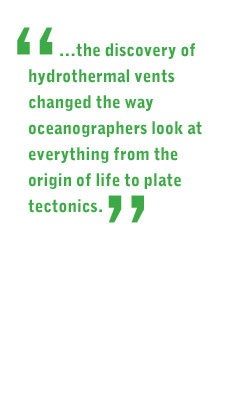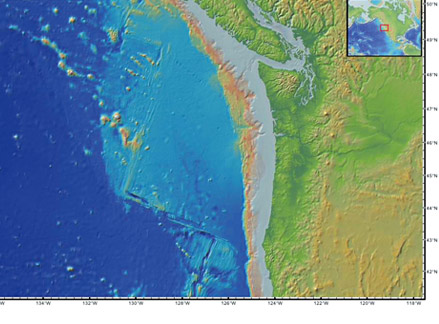


Listening to the Earth from Under
the Sea
by Carole VanSickle
Intro
| Where It All Began
| Seismic Forecasts?
| A Versatile Tool

![]()

Where It All Began
The first hydrothermal vent was discovered in 1977 at the Galapagos Rift, an area of great geologic activity that spawned the Galapagos Islands — a volcanic chain west of Ecuador.
“There are not a lot of times when a paradigm shift occurs and changes the way you view all aspects of your field,” Di Iorio said, “but the discovery of hydrothermal vents changed the way oceanographers look at everything from the origin of life to plate tectonics.”

A large-scale image showing the Juan de Fuca Plate, complete with the Cascadia subduction zone, transform faults and mid- ocean spreading zones along the Juan de Fuca Ridge.
Hydrothermal vents form when the earth’s crust spreads apart, allowing seawater to rush into the cracks and mix with molten lava. The water becomes “super-hot,” Di Iorio said, which results in interactions with the oceanic crust and other materials so dramatic that the water emerges from the vents with a completely altered chemical composition. The aqueous mixture of inorganic elements such as iron, sulfur and barium hurtles upward as a result of its high temperature.
Surprisingly, these plumes are the basis for unique ecosystems that exist entirely independently of sunlight [see sidebar on p. 15]. “When scientists discovered hydrothermal vents, they found an enormous biological ecosystem where microbes perform chemosynthesis — turning chemicals into nutrients — instead of photosynthesis to get their energy,” Di Iorio said. “The first research team never even thought to bring a biologist along because they figured ‘What could live at 2,200 meters, where there’s no light and no food?’ But it turns out that these microbes probably evolved to initiate the chain of events leading up to where we are today, since they are examples of the earliest life on earth.”
Intro
| Where It All Began
| Seismic Forecasts?
| A Versatile Tool
For comments or for information please e-mail: rcomm@uga.edu
To contact the webmaster please email: ovprweb@uga.edu
![]()